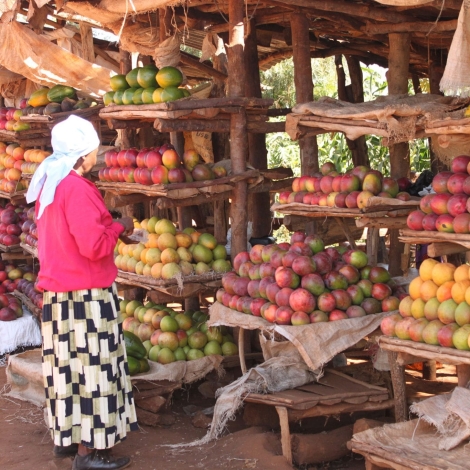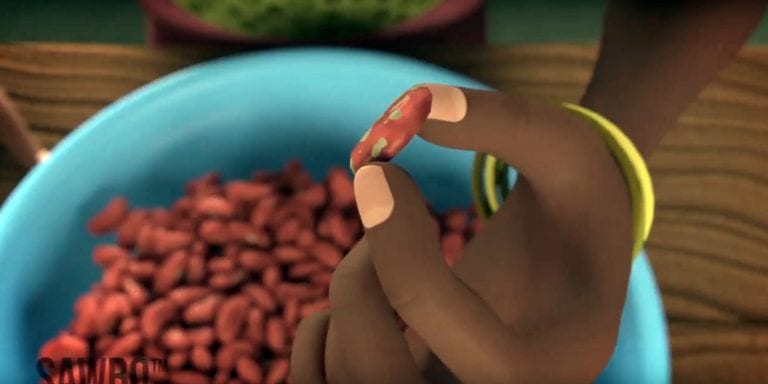Mango season closes this month on Kenya’s coast, seeing some mango harvesters continue to employ the traditional method of shaking trees until the fruit drops. Bruised and broken-skinned fruit collect on the ground. Damaged fruit may last a few days for local sale or it may be tossed out. Mango is a fragile fruit that is often lost after harvest.
Agriculture is the backbone of Kenya’s economy, contributing to about 24 percent of the Gross Domestic Product. An estimated 75 percent of the population depends on agriculture directly or indirectly. The horticulture sub-sector has experienced significant growth (4 percent from 2015 to 2016) and has become a major source of employment and a source of government revenue. The sector impacts the livelihood of many people. In 2016, the fruit sub-sector contributed Kshs.57 billion (27 percent of domestic horticultural product). Fruit shows great potential, especially for small farmers. There is a country-wide need for key technologies to prevent food waste, however.
Small farmers can increase their income significantly by addressing their 30 percent product loss
Mangoes have become a significant income source for small farmers from dry areas, due to increasing demand on domestic, regional and international markets. However, mangoes are highly perishable. The fruit has a short shelf life of about 4-5 days at room temperature (25°C) and about 3 weeks in cold storage (13°C). Some of the factors that contribute to the mango’s quick deterioration in quantity and quality include poor harvesting techniques resulting in mechanical damage, insect pest (fruit fly, white fly and seed weevil) causing fruit damage and rot, and immature harvesting, all accounting for 20-30 percent of the fruit loss. Additionally, poor packaging, transportation and market glut contribute to about 6-10 percent loss.
Traditionally, fruits like mangos are harvested by shaking the trees or climbing them to pick and drop the fruit on the ground. These methods damage the fruit, which increases water loss, oxidation, release of stress ethylene and broken skins where pathogens can enter and decay the fruit. To meet this challenge, tools have been developed that allow for the ‘soft’ landing of fruits during harvest. Namely, harvesting poles and nets. It is also important to place fruit on a clean surface facing down to allow its natural latex to drip and the skin to dry. Otherwise, the fruit’s skin can ‘burn’ and it will not look appealing. Fruit packing and transportation is key in complementing careful harvest. Timber or plastic crates are best suited for fruit, offering more cushioning and greater air circulation (reducing respiration heat).
During peak season the market is not able to absorb all of the product. Losses are great.
During the peak season (December to January), the market is not able to absorb all of the product. Losses are great. Surplus fruit rots. But new technologies such as evaporative coolers (ECTs), CoolBot, waxing and drying can be used to extend shelf life. ECTs such as Charcoal cooler, zero energy brick cooler and pot-in-pot work on the principle of evaporation. Heat is removed as water evaporates from the surface of the storage device, decreasing temperature (up to 15oC below ambient temperatures) and increasing in humidity (up to 50 percent above ambient), conditions that substantially improve vegetable shelf life, increase the marketing period, reduce food loss, and ultimately increase income for farmers. Unlike conventional refrigerators, these cooling systems do not require electricity to run and they can be fabricated with locally available materials, making it easier to acquire and operate. CoolBot, an alternative cooling technology, costs only a fraction of a commercial refrigerator. In a walk-in cold room, CoolBot is connected to a standard air conditioner and overrides it to give lower temperature (0C) without ice forming on the coils. The device allows adjustment of temperatures to desired levels allowing storage of different commodities with different temperature requirements. CoolBot requires electricity, which can be an impediment for small rural farmers.
Urbanization and modernism have widened the gap between farms and cities. Food processing technologies can add value by transforming ripe mangoes into juice, pulp, concentrate and dried chips; allowing products to reach distant local and international markets. Adoption and use of technology such as a solar tunnel dryer, green-house dryer and dehytray dryer has been on the increase. These facilities are used not only to dry fruits, but vegetables and grains too. The dried products have longer shelf life ensuring their availability even during the off season. Fruit pulp has longer shelf life compared to fresh mangos, and this product can be used to make drinks, jams, concentrate, among others, during the lean season.
Government and Non-Government Organizations in Kenya are empowering farmer and farmer groups through training and acquisition of different equipment for processing. This trend has reduced losses in the mango value chain with income gains observed in Karurumo and Masii Horticultural Cooperative societies, initiated under the YieldWise project in Kenya.
Small farmers can increase their income significantly by addressing their 30 percent product loss, with the incorporation of this improved harvesting, post harvesting and food processing technologies, therefore boosting Kenya’s economy and improving life quality of farmers.
About the Author
Benson is an E4C Research Fellow 2019. He studies horticulture at the University of Nairobi, focusing on postharvest management and technologies. His research is in postharvest tools that can be employed to curb the high losses in the fruit sub-sector in the country. He is also involved in the development of aggregation centers for smallholder farmers and equipping them with low-cost cooling facilities for storage of their produce.

